Featured Snippets Content Across the Wider SERP in 2022
In 2022, Featured Snippets are part of the journey, not the final destination. The continued integration of topic filtering elements across the SERP means that content from ‘position 0’ is showing in many more parts of the search results.
Where is Featured Snippet Content Displayed in 2022?
Content that has been extracted by Google for Featured Snippets can now be seen across the SERP as component parts of a multilayered topic landscape. This means that rather than being a single element of the SERP, today FS content excerpts can be seen in:
- The classic Featured Snippet
- People Also Ask
- Voice Assistant Results
- Knowledge Panels
- Topic Accordions
- Topic Verticals
- Featured Snippet Dropdowns
So content that ranks for Featured Snippets has become more widely distributed across the SERP. In this environment, sites using a topic-led approach to content will have multiple opportunities to gain visibility via content from Featured Snippet paragraphs.
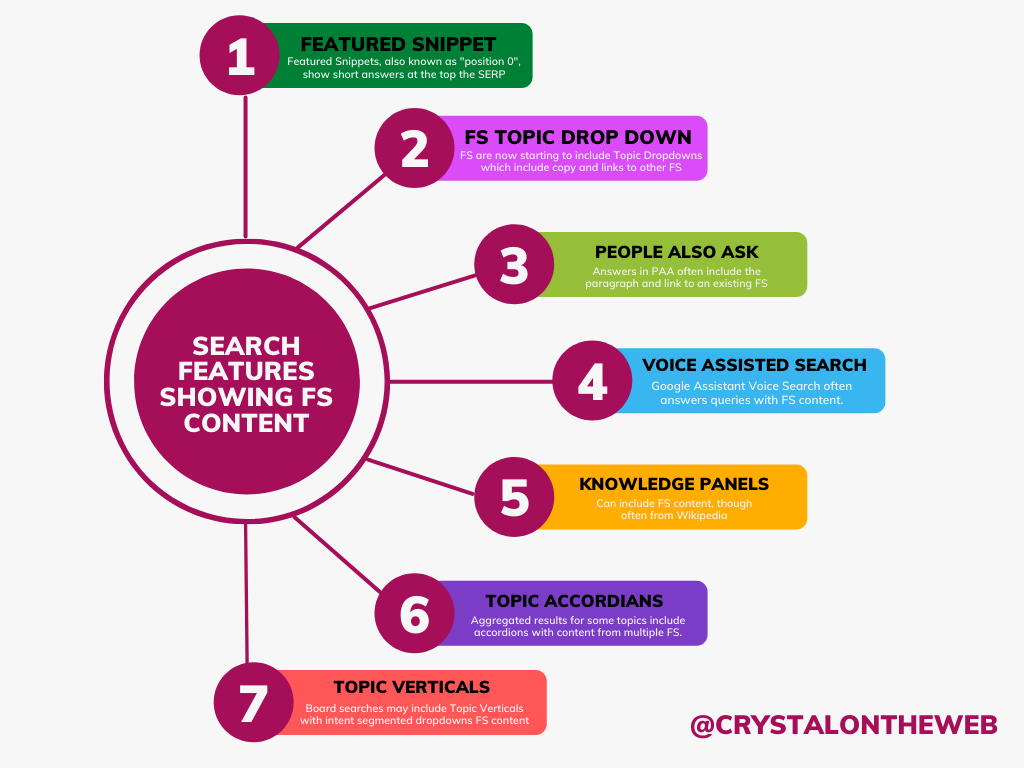
Classic Featured Snippet
The most common location for a Featured Snippet, is right at the top of the SERP, and is sometimes referred to as position 0. This has been the case since Featured Snippets were first introduced around 2014 and is something that I anticipate will continue for the foreseeable future.
Featured snippets appear in about 8% results and the most commonly seen Featured Snippet is the Paragraph Snippet.
These snippets are selected from well-formatted content (with headers) that answer questions or queries clearly and succinctly, often within around 60 words.
This is an example of the Featured Snippet for the query who invented the Cha Cha, which follows the typical behavior of a Featured Snippet paragraph.
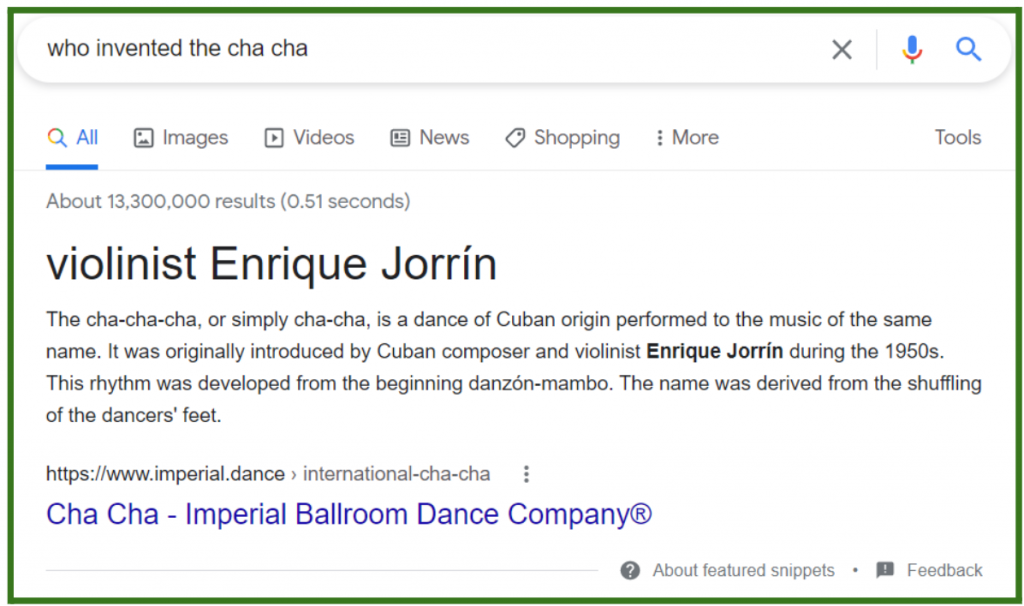
Voice Search & Google Assistant
Another staple use for Featured Snippets is providing answers for Voice Search in Google Assistant.
So this is an example of the displayed result when I asked Google Assistant who invented the cha cha.
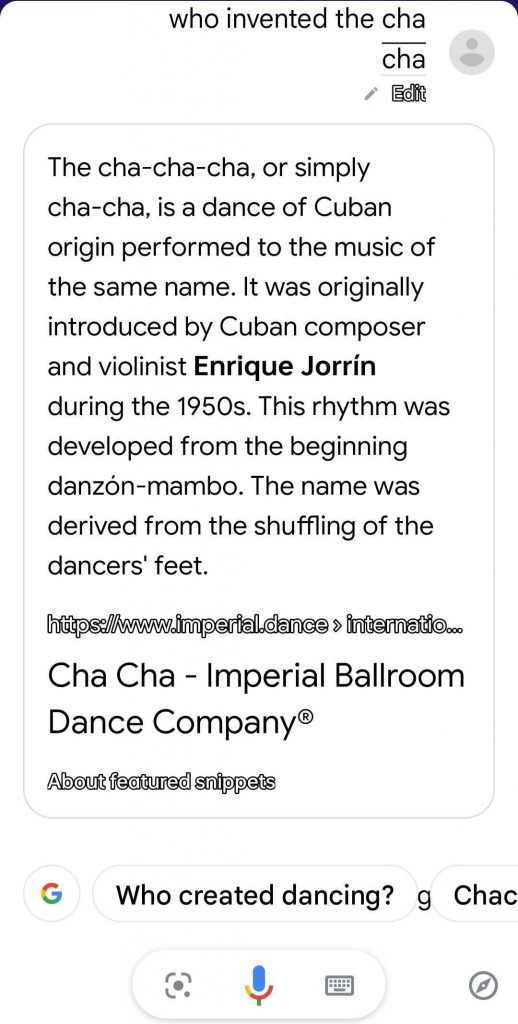
Reassuringly, the Featured Snippet here is the same as the desktop search result. Additionally, this content is clearly labeled as a Featured Snippet. In both cases, we are displaying a paragraph excerpted from the Imperial Dance website, suggesting that FS visibility for these kinds of queries is fairly stable.
People Also Ask
So here is where it starts to get interesting.
When we look up the related query, cha cha invention, we see that Imperial Dance is no longer showing as the top Featured Snippet. But, with a few clicks, we can find that the same FS content that we found before is showing as a PAA result. This is not labeled as a FS because it isn’t, but we can see that the content is the same.
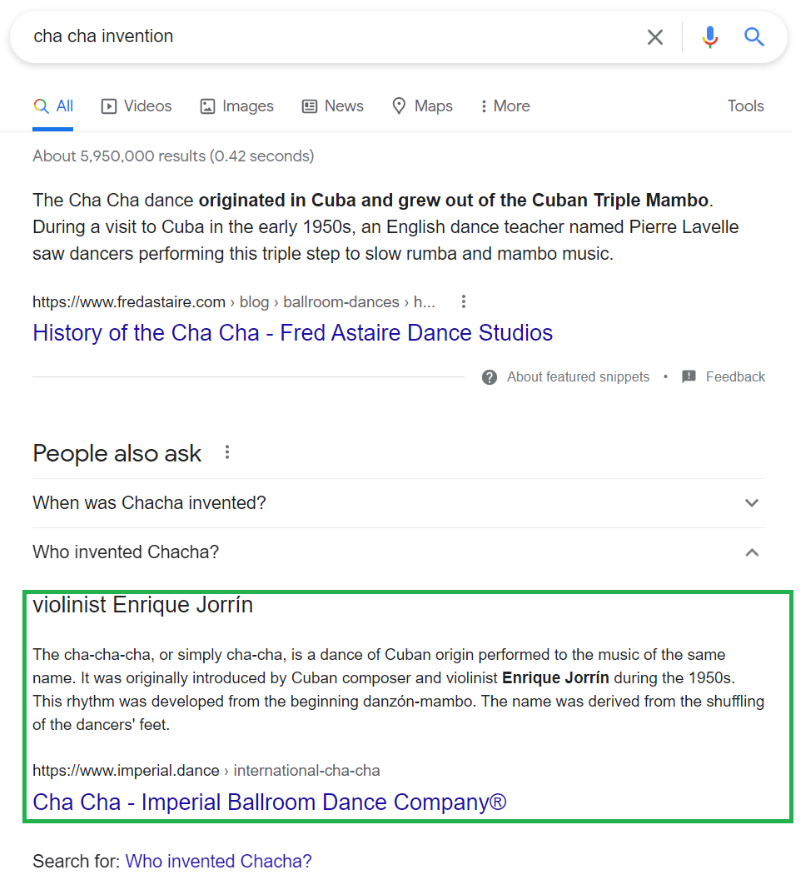
Feature Snipped extracts in Knowledge Panels
We see a similar experience when we compare the content in Knowledge Panels. For instance, the band Cypress Hill has a Knowledge Panel for the query Cypress Hill. Additionally, we see the band description is the same content that shows for the Featured Snippet for the query how many albums has Cypress Hill sold. Keep in mind that this Wikipedia content is almost certainly not optimized for this particular query but because it answers the question as a Featured Snippet and as a Knowledge panel detail.
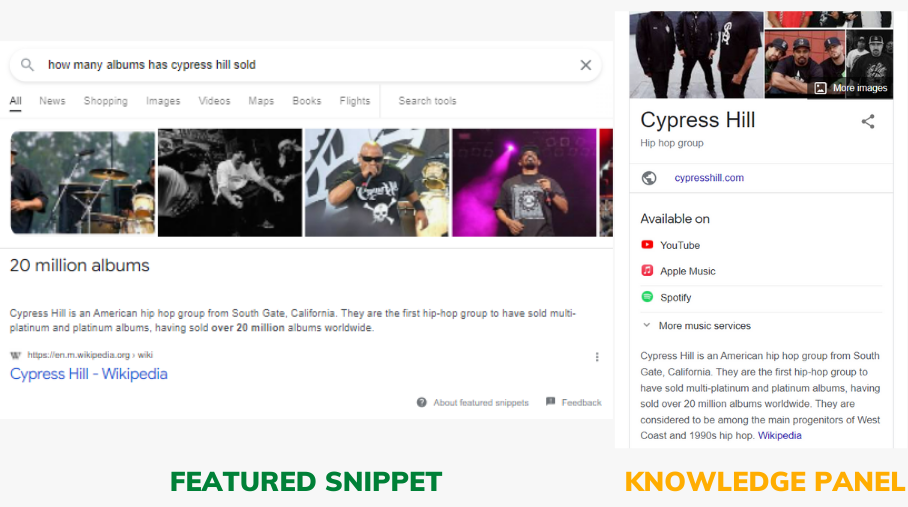
When thinking about creating content that could show in this way, it is important to remember the headline-style information for a Knowledge Panel entity (which is likely to be queried) and ensure that information is concisely delivered.
Feature Snipped extracts in Topic Accordions
When Google aggregates results for topics, it sometimes places them in what I like to call “Topic Accordions.” In these instances, you will see the query bar followed by the phrase from sources around the web. Then there will be a list with lots of dropdowns which contain multiple search results. In many cases, the content from here comes from content which also appears as a Featured Snippet for a related query.
In the case of the query blog topics, we see a topic accordion with a drop down for the ‘Fashion’ section which leads to a Wix article on 120 profitable blogs. We also see the same article showing as a People Also Ask result for the query blog topics for beginners. And, in both cases, the content has been selected with the original ranking and the Featured Snippet for the query topics for blogs.
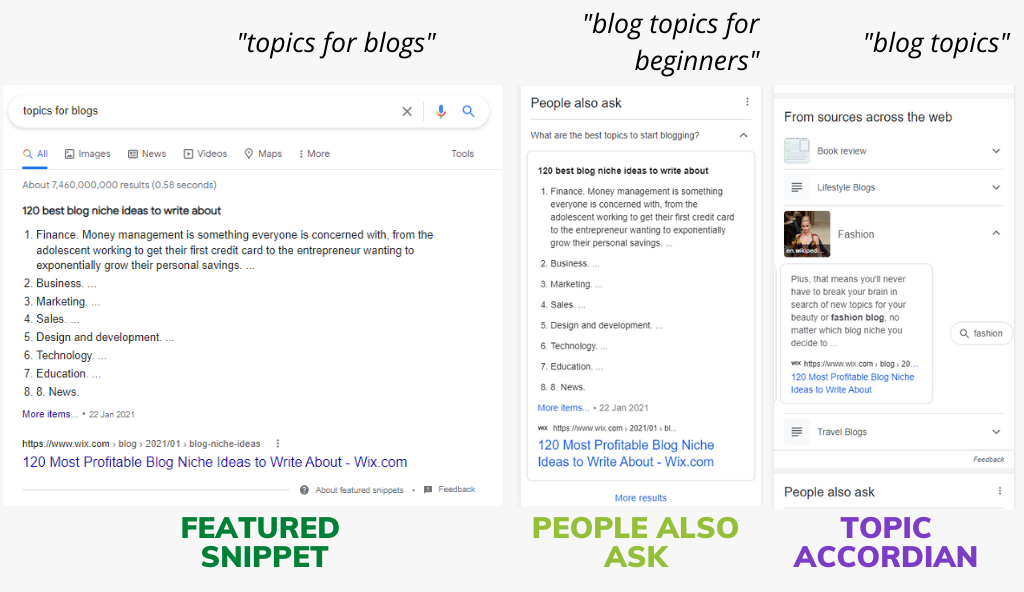
In this instance, the FS is not a final destination in terms of satisfying users’ queries, rather the content of the FS is part of Google’s wider topic landscape. This includes multiple entry points and intents, which is reflected in how the content is surfaced.
SEOs who wish to optimize for this should have a clear understanding of the complete user journey for a given topic and create content that could potentially work well in each SERP element simultaneously.
Feature Snipped extracts in Topic Verticals
Similar to Topic Accordions, Topic Verticals also include content from FS, segmented by subtopics. Topic Verticals tend to appear for very broad searches and are designed to funnel Google users into more targeted searches with clearer intent, or to address common questions directly within the SERP.
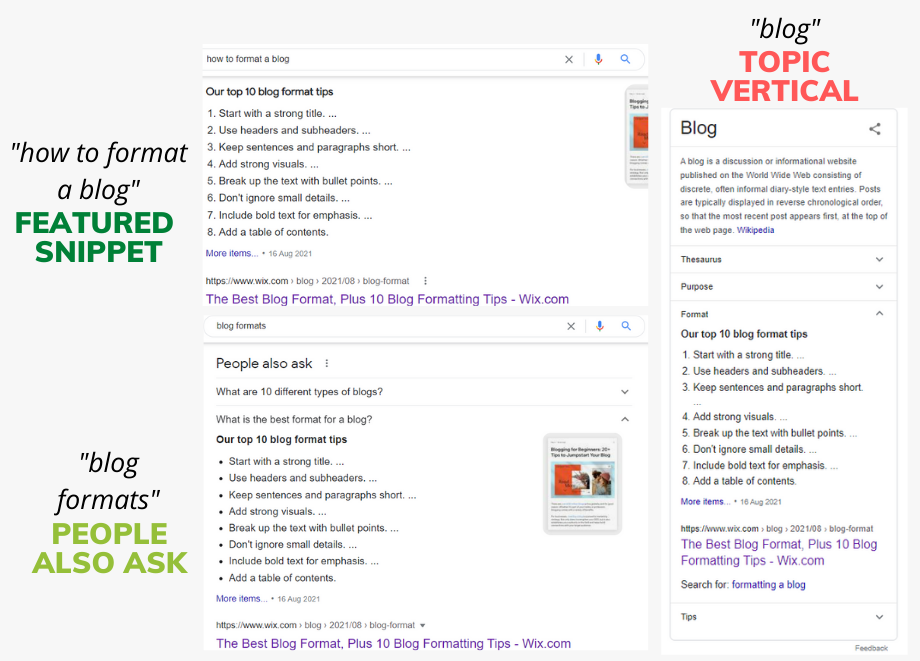
Here is an example of the Topic Vertical for the query blog. Here we see that Google is funneling users to common subtopics. Within the subtopic for Format, you can see content from the FS for the query, how to format a blog. And within wider topic architecture for blog, the same FS content is being shown as a People Also Ask result for the query blog formats.
As with the Topic Accordion, the Topic Vertical is surfacing content from FS via subtopic segments. So the FS content has multiple opportunities to connect with users around this topic.
Featured Snippet content in Featured Snippets
Given Google’s fairly dynamic use of FS content across the SERP, the recent evolution of Featured Snippet content showing within Featured Snippets themselves should come as no surprise.
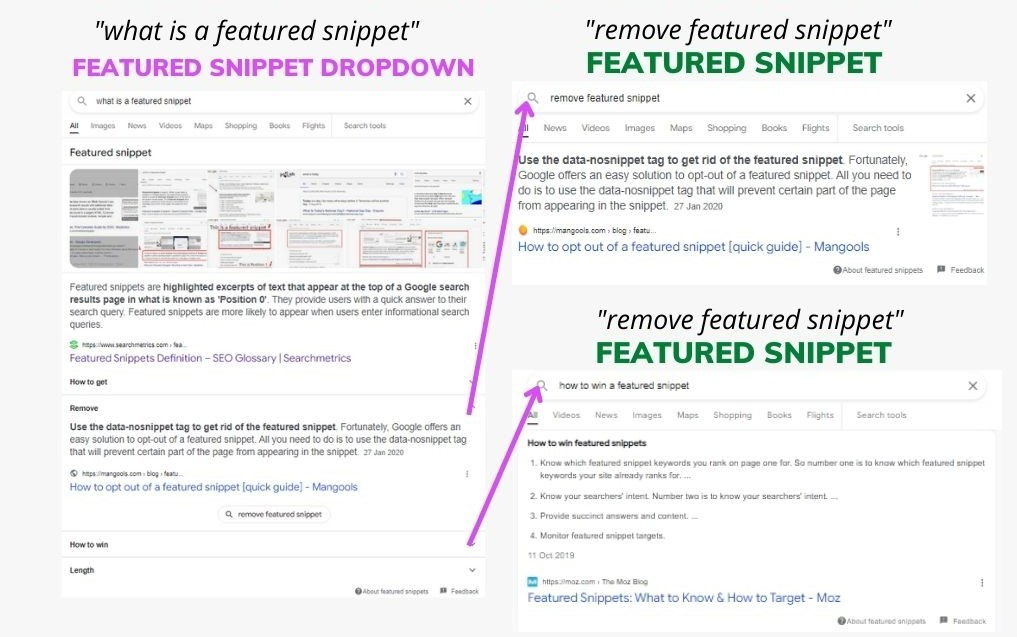
For the query what is a featured snippet, we can see a hybrid of some of the other SERP elements that include FS content. So the search feature is declared just below the search bar as Featured Snippet, then the standard FS content is displayed. After the FS paragraph, we see the same subtopic funnel technique as the Topic Vertical, and within those dropdowns, we see additional FS content. Not only that, but if you click on each one, you are taken to an additional FS for the subtopic.
SEOs have also observed that Google seems to be experimenting with surfacing FS copy from multiple sources, so this trend is likely to persist and evolve in the future.
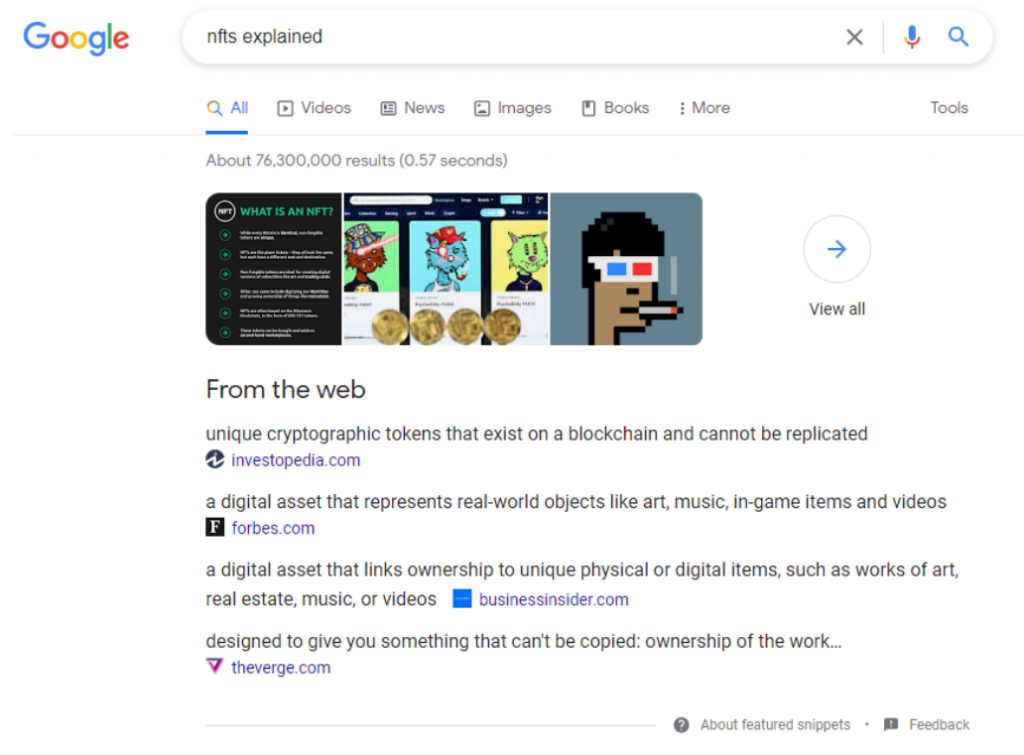
In this SERP landscape, the FS is part of the customer’s information discovery journey rather than the ultimate destination. Those who optimize content for topics and intent — instead of a single keyword at a time — are much more likely to benefit from this more multi-faceted interface.